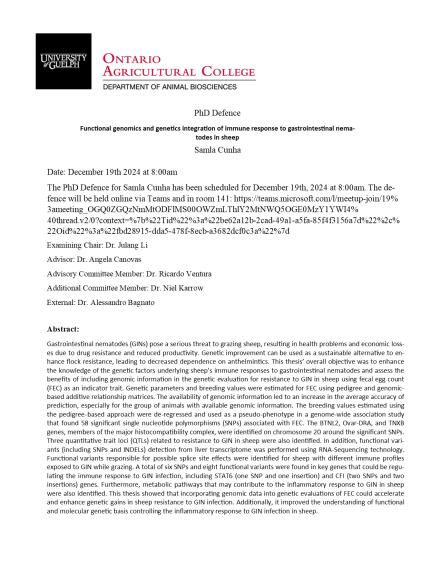Room 141 and Teams: https://teams.microsoft.com/l/meetup-join/19%3ameeting_OGQ0ZGQzNmMtODFlMS00OWZmLThlY2MtNWQ5OGE0MzY1YWI4%40thread.v2/0?context=%7b%22Tid%22%3a%22be62a12b-2cad-49a1-a5fa-85f4f3156a7d%22%2c%22Oid%22%3a%22fbd28915-dda5-478f-8ecb-a3682dcf0c3a%22%7d

Functional genomics and genetics integration of immune response to gastrointestinal nema-todes in sheep
Gastrointestinal nematodes (GINs) pose a serious threat to grazing sheep, resulting in health problems and economic loss-es due to drug resistance and reduced productivity. Genetic improvement can be used as a sustainable alternative to en-hance flock resistance, leading to decreased dependence on anthelmintics. This thesis’ overall objective was to enhance the knowledge of the genetic factors underlying sheep's immune responses to gastrointestinal nematodes and assess the benefits of including genomic information in the genetic evaluation for resistance to GIN in sheep using fecal egg count (FEC) as an indicator trait. Genetic parameters and breeding values were estimated for FEC using pedigree and genomic-based additive relationship matrices. The availability of genomic information led to an increase in the average accuracy of prediction, especially for the group of animals with available genomic information. The breeding values estimated using the pedigree-based approach were de-regressed and used as a pseudo-phenotype in a genome-wide association study that found 58 significant single nucleotide polymorphisms (SNPs) associated with FEC. The BTNL2, Ovar-DRA, and TNXB genes, members of the major histocompatibility complex, were identified on chromosome 20 around the significant SNPs. Three quantitative trait loci (QTLs) related to resistance to GIN in sheep were also identified. In addition, functional vari-ants (including SNPs and INDELs) detection from liver transcriptome was performed using RNA-Sequencing technology. Functional variants responsible for possible splice site effects were identified for sheep with different immune profiles exposed to GIN while grazing. A total of six SNPs and eight functional variants were found in key genes that could be regu-lating the immune response to GIN infection, including STAT6 (one SNP and one insertion) and CFI (two SNPs and two insertions) genes. Furthermore, metabolic pathways that may contribute to the inflammatory response to GIN in sheep were also identified. This thesis showed that incorporating genomic data into genetic evaluations of FEC could accelerate and enhance genetic gains in sheep resistance to GIN infection. Additionally, it improved the understanding of functional and molecular genetic basis controlling the inflammatory response to GIN infection in sheep.

